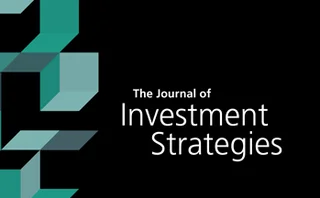Journals
Comments on the Basel Committee on Banking Supervision proposal for a new standardized approach for operational risk
In this paper, the behavior of the SMA is studied under a variety of hypothetical and realistic conditions, showing that the simplicity of the new approach is very costly.
Should the advanced measurement approach be replaced with the standardized measurement approach for operational risk?
This paper discusses and studies the weaknesses and pitfalls of the SMA and the implicit relationship between the SMA capital model and systemic risk in the banking sector.
Multifactor risk models and heterotic CAPM
The authors of this paper give a complete algorithm and source code for constructing general multifactor risk models via any combination of style factors, principal components and/or industry factors.
The effective supply of collateral in Australia
This paper attempts to quantify the “effective” supply of collateral assets in Australia by applying a measure of supply that adjusts outstanding issuance for two important features of the collateral market.
The role of collateral in supporting liquidity
This paper focuses on the use of high-quality assets for collateral purposes.
Mobilization of collateral in Germany as a reflection of monetary policy and financial market developments
This paper describes and analyzes developments in the market value of marketable assets submitted as collateral in Germany and the Eurosystem against the backdrop of the financial market crisis.
Collateral flows and balance sheet(s) space
This paper looks at securities-lending, derivatives and prime-brokerage markets as suppliers of collateral.
Impact of monetary policy on collateral reuse
The authors provide theoretical microfoundations to understand the impact of monetary policy on markets characterized by collateral reuse.
Collateral chains and incentives
The authors model the asymmetry between collateral values to the parties in the collateral chain. The paper highlights that collateral reuse can be socially beneficial if the costs of misallocation are not significant.
Systematic analysis of the evolution of electricity and carbon markets under deep decarbonization
A computationally intensive, multimethod modeling process is undertaken to address the question of whether carbon markets can offer the desired solution of balancing initiatives for technological change while maintaining a commitment to market…
Some options for evaluating significant deterioration under IFRS 9
The authors of this paper address some issues to do with IFRS 9 and explain how to determine if an instrument has suffered serious deterioration in credit risk.
Fractional Kelly strategies with low-risk stocks
This paper uses the fractional Kelly strategies framework to show that optimal portfolios with low-beta stocks generate higher median wealth and lower intra-horizon shortfall risk.
A correlated structural credit risk model with random coefficients and its Bayesian estimation using stock and credit market information
Using historical equity and credit market data, this paper illustrates the validation of a structural correlated default model applied to Black–Cox setups.
Modeling joint defaults in correlation-sensitive instruments
This paper presents a simple model for joint defaults and shows how it can be applied to pricing and risk-managing instruments that are sensitive to credit correlation.
The effect of market conditions on forward-looking portfolio performance
The authors of this paper apply a forward-looking approach to the minimum variance portfolio optimization problem for a selection of 100 stocks.
The determinants of regime switching in the natural gas and crude oil cointegrating relationship
This paper aims to find determinants of the endogenous regime-switching process underlying the cointegrating relationship between natural gas and crude oil.
Value-at-risk bounds for multivariate heavy tailed distribution: an application to the Glosten–Jagannathan–Runkle generalized autoregressive conditional heteroscedasticity model
This paper aims to derive VaR bounds for the portfolios of possibly dependent financial assets for heavy tailed Glosten–Jagannathan–Runkle generalized autoregressive conditional heteroscedasticity processes using extreme value theory copulas.
Finite difference techniques for arbitrage-free SABR
This paper applies a variety of second-order finite difference schemes to the SABR arbitrage-free density problem and explores alternative formulations.
An analysis of energy futures
The authors of this study investigate the distributions of returns on crude oil, heating oil and natural gas futures.
Rapidly bounding the exceedance probabilities of high aggregate losses
The authors of this paper assess the right-hand tail of an insurer’s loss distribution for a specified period (a year), presenting and analyzing six different approaches in doing so.
A mixed Monte Carlo and partial differential equation variance reduction method for foreign exchange options under the Heston–Cox–Ingersoll–Ross model
The paper concerns a hybrid pricing method build upon a combination of Monte Carlo and PDE approach for FX options under the four-factor Heston-CIR model.
Estimating credit risk parameters using ensemble learning methods: an empirical study on loss given default
This study investigates two well-established ensemble learning methods: Stochastic Gradient Boosting and Random Forest, and proposed two new ensembles.
Rating-transition-probability models and Comprehensive Capital Analysis and Review stress testing: methodologies and implementation
This paper introduces a risk component called the credit index, that represents the systematic risk part of a portfolio by a list of macroeconomic variables.






